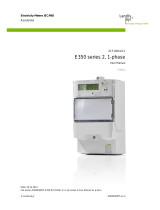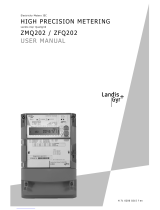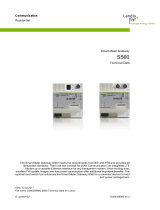
Ultrasonic Heat and Cooling Meter
ULTRAHEAT®T550 (UH50...)
ULTRACOLD®T550 (UH50…)
17.11.2021
Translation
T550 (UH50...)
Landis+Gyr GmbH Subject to change without prior notice 17.11.2021 1
Note: These operating instructions remain with the end user following installation.
Note: In the following text, the term meter refers to
both the heat meter, the cooling meter and the flow
meter, unless they are otherwise differentiated.
1. General
1.1 Use
The T550 (UH50…) is used as a meter for heating or cooling
consumption measurement in systems with water.
The meter consists of two temperature sensors and an elec-
tronic unit that calculates the energy consumption from the
volume and temperature difference.
1.2 General notes
The meter left the factory in a faultless condition where safety
is concerned. The manufacturer will provide additional tech-
nical support on request. Calibration relevant security seals on
the meter must not be damaged or removed. Otherwise, the
warranty and calibration validity of the meter will no longer
apply.
• Keep the packaging so that you can transport the meter in
its original packaging following expiry of the calibration va-
lidity.
• Lay all cables at a minimum distance of 500 mm to high
voltage and high frequency cables.
• A relative humidity of < 93 % at 25 °C is permissible (with-
out condensation).
• Avoid cavitation in the whole system due to overpressure
i.e. at least 1 bar at qp and approx. 3 bar at qs (applies for
approx. 80 °C).
• At a heat meter or combined heat/cold meter the mounting
place of the flow sensor cold side is equivalent to return.
The mounting place of the flow sensor hot side is equiva-
lent to flow.
• At a cooling meter the mounting place of the flow sensor
hot side is equivalent to the return. The mounting place of
the flow sensor cold side is equivalent to flow.
2. Safety Information
The meter may only be used in building service engi-
neering systems and only for the applications de-
scribed.
The local regulations (installation etc.) must be ad-
hered to.
The operating conditions according to the type plate
must be complied with during use. Non-compliance
can result in hazardous situations and the expiry of all
claims arising from liability for defects as well as liabil-
ity based on any expressly granted guarantees.
Requirements for circulating water (CEN/TR 16911:
2016).
The meter is only suitable for circulating water in heat-
ing systems.
The meter is not suitable for drinking water.
Do not lift the meter by the electronic unit.
Be aware of sharp points on the edges, flange and
measuring tube.
Only personnel, trained in the installation and opera-
tion of meters in heating and cooling systems, may
install and remove the meter.
Only install or remove the meter when the pipes are
pressure-less.
After installing the meter, check the leak-tightness of
the system.
Guarantee and calibration validity will lapse if the
calibration relevant security seals are broken.
Only clean the meter from outside with a soft, lightly
wetted cloth. Do not use any spirit or cleaning solvent.
The 110 V / 230 V connections may only be made by
an electrician.
The meter may only be powered up once the installa-
tion has been completed. There is otherwise a danger
of electronic shock on the terminals.
A defective or obviously damaged appliance must be
disconnected from the power supply immediately and
replaced.
As far as disposal is concerned, the meter is a waste
electronic appliance in the sense of European Di-
rective 2012/19/EU (WEEE) and it must not be dis-
posed of as domestic waste. The relevant national,
legal regulations must be observed as the appliance
must be disposed of via the channels provided for this
purpose. The local and currently valid legislation must
be observed.
The meter contains lithium batteries. Do not dispose of
the meter and the batteries with domestic waste. Ob-
serve the local stipulations and laws on disposal.
You can return the lithium batteries to the manufactur-
er for appropriate disposal following use. When ship-
ping please observe legal regulations, in particular,
those governing the labelling and packaging of haz-
ardous goods.
Do not open the batteries. Do not bring batteries into
contact with water or expose to temperatures above
80 °C.
The meter does not have any lightning protection.
Ensure lightning protection via the in-house installa-
tion.
Only fit one compartment for the power supply. Do not
remove the red locking hatch.













